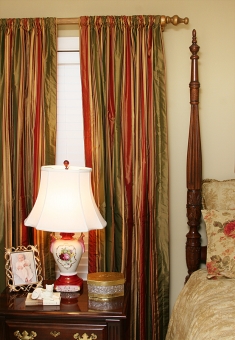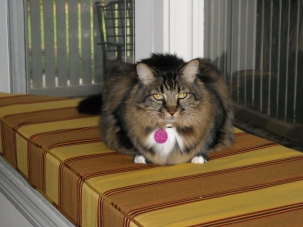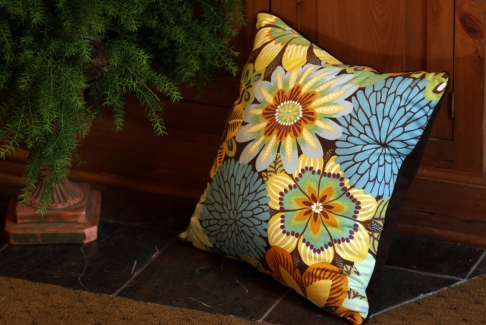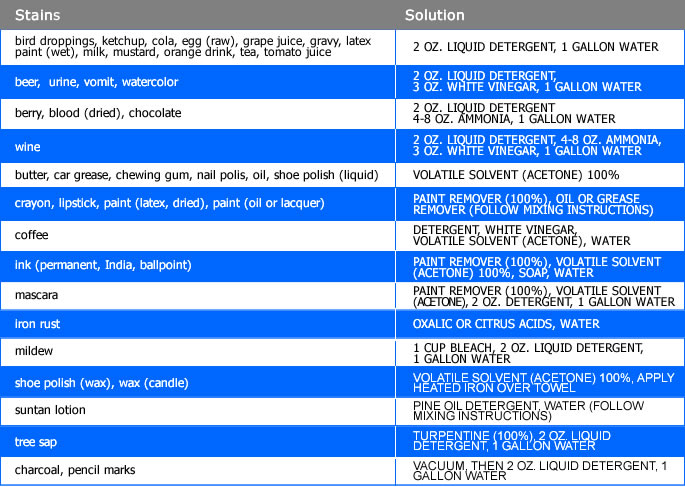Fabric Care & Cleaning Instructions

Outdoor Drapes offers a variety of fabrics for custom drapes, cushions, pillows and more! Select your topic of interest from our list below for more information regarding care and cleaning.
- General Upholstery Care & Cleaning
- Silk Care & Cleaning
- Sunbrella Care & Cleaning Overview
- Sunbrella Indoor Furniture
- Sunbrella Outdoor Furniture
- Sunbrella Difficult Stain Removal
- Maintaining Sunbrella's Water Repellency
- Robert Allen Fabric Care
- Outdura Care & Cleaning Overview
- Outdura Indoor Furniture
- Outdura Outdoor Furniture
- Outdura Difficult Stain Removal
- Maintaining Outdura's Water Repellency
General Care & Cleaning Tips for Upholstery
Upholstered fabric can be a great choice for furniture and other products, but it is important for homeowners to take the time to learn how to clean and care for their fabric the right way. With prices of furniture steadily on the rise, it has never been more important for those couches, chairs and ottomans to last as long as possible. With the right care, upholstered furniture can provide many years of trouble free service.
There are simple ways homeowners can help to enhance the useful life of their upholstered furniture. Some of these upholstery-friendly care tips include:
- Giving the upholstered furniture a light brushing and vacuuming at least once a week will help to remove dirt from the fabric. A light brushing will help to keep the fabric clean and keep dirt from penetrating the upholstery.
- The cushions on upholstered furniture should be reversed and turned once a week as well. This frequent turning will help the cushions wear evenly. Reversing the cushions on a regular basis will also help you spot any stains early, before they have had time to set.
- If any spots or stains are noted, be sure to remove them right away using a mild cleanser. When cleaning the upholstered furniture, always start with the weakest solution possible, slowly building the concentration until the stain has been fully eradicated.
- An ounce of prevention can be worth a pound of cure when it comes to protecting and preserving expensive upholstered furniture. Those with children or pets may want to consider using a cover to protect the furniture. The cover can both help to prevent stains and make their removal a lot easier.
- When it its time to clean the upholstery, it is important to choose an effective cleaner. Choose a cleaner that is safe for your fabric, and one that does not contain any harsh chemicals or abrasive elements. It is also a good idea to choose a cleaner that both cleanses and deodorizes.
- Before cleaning the upholstery, brush or vacuum away the loose dirt first. This will help to avoid rubbing in any existing dirt as the fabric is cleaned.
- A strong brush can be used to apply the cleaner to stained areas. When brushing the stained area, avoid rubbing or scrubbing the fabric too hard.
- After a minute or two the cleaner can then be carefully wiped away using a damp sponge or cloth.
- The upholstery should be carefully dried after it has been cleaned. Leaving a window open or running a fan will help the fabric dry more quickly and more thoroughly.
Cleaning upholstered fabrics is not always easy, but it is important to care for these special fabrics carefully. With the right care and the right cleaning, fine upholstered fabrics can retain their wonderful good looks for many years to come.
By B. E. Conrad (www.doityourself.com)
Silk Fabric Care & Cleaning
Dry cleaning is recommended for silk.
In the event that you wish to wash silk, please note the following.

Hand Washing
- Before washing, test for color fastness.
- Dip a small piece of the silk in cold or tepid water.
- Take a piece of white cotton fabric and lay it over the silk, then press with a warm iron. If there is any transfer of color to the white fabric other than a faint mark, do not wash the item.
- Never soak, boil or bleach silk.
- Never try to remove stains yourself. Silk threads (Light colors only) may be hand-washed in tepid water (35°C maximum) with the addition of a washing product for delicate lingerie e.g., soap flakes or gentle detergent.
- Rinse thoroughly three times using hand hot water for each rinse.
- Roll the article in a clean dry towel to remove surplus water.
- Never leave it in a towel or in a crumpled condition.
- Allow to dry if necessary in an airy place away from the sun and direct heat but only until the material if slightly and evenly damp with a cool iron taking special care not to apply too great a pressure over seams.
- Do not use a steam iron and do not attempt to redamp locally.
- Finish off lightly on the right side.
- Warning! Be very careful with dark colors. (Dark marine, dark brown, bright red, green or purple...) they are obtained by addition of coloring matters and color fastness cannot be guaranteed.
- The international group for textile labeling defines the symbol for hand washing as equivalent to a washing temperature from 30 to 40°C.
- Given the delicacy of silk, the commission of technology and research of the A.I.S. (International Silk Association) at LYON specifies that the temperature should not be higher than 35°C.
General Silk Care
- Silk should only be dry cleaned.
- Possible shrinkage 3%.
- Do not spot clean untreated silk and do not wash silk.
Drapes & Curtains Silk Care
- Silk should only be dry cleaned.
- Possible shrinkage 3%.
- Do not spot clean untreated silk and do not wash silk.
- Remove hooks, rings and trim before cleaning. Do not allow dust to accumulated - gently vacuum with the appropriate attachment regularly.
Possible Shrinkage
- THAI SILK - Possible shrinkage 3%.
- SLUBBED DUPION - This fabric has a slightly looser weave, shrinkage is possible. We recommend puddling of curtains and generous hem allowances. Possible shrinkage 3%.
- MACHINE-LOOM SMOOTH DUPION - Extra allowance is essential, especially in areas of varying humidity and puddling curtains on the floor is desirable. Possible shrinkage 5%.
- Silk must be protected from the sun.
Back to Top
Sunbrella Care & Cleaning Overview
One of the best ways to keep Sunbrella fabrics looking good and to delay deep or  vigorous cleaning is to properly maintain the fabrics. This can be accomplished by simply brushing off dirt before it becomes embedded in the fabrics, wiping up spills as soon as they occur or spot cleaning soon after stains occur.
vigorous cleaning is to properly maintain the fabrics. This can be accomplished by simply brushing off dirt before it becomes embedded in the fabrics, wiping up spills as soon as they occur or spot cleaning soon after stains occur.
View the Sunbrella fabric Stain Chart for recommended cleaning solutions.
Back to Top
Sunbrella Indoor Furniture
Indoor furniture care & cleaning (pdf) / Stain Chart (pdf)
For Removable Cushion Covers and Slipcovers:
Hand washing
1. Soak fabric in a solution of 1/4 cup mild soap per gallon of lukewarm water.
2. Use a sponge or a soft bristle brush as necessary.
3. Rinse thoroughly to remove all soap residue.
4. Air dry

Spot cleaning upholstered pieces
1. Apply a light mist of mild soap and water using a spray bottle.
2. Remove stain with a sponge or very soft bristle brush.
3. Rinse thoroughly to remove all soap residue.
4. Wet-vacuum or blot excess water.
5. Air dry, Repeat steps 3 and 4 until all soap residue is removed.
For stubborn stains and/or mildew
Sunbrella fabric does not promote mildew growth, however, mildew may grow on dirt and other foreign substances that are not removed from the fabric.
1. Prepare a solution of 1 cup bleach and 1/4 cup of mild soap per gallon of clean water.*
2. Soak affected area in solution for 15 minutes.
3. Remove stain with a sponge, clean towel or very soft bristle brush until all soap residue is removed.
4. Rinse thoroughly to remove all soap residue.
5. Air dry.
*If stain and/or mildew are severe, bleach quantities may be increased. See our Stain Chart for removal of specific stains.
Re-treating the fabric for ease of cleaning
Sunbrella fabrics have a special finish that enhances water repellency. The finish is designed to last for several years of normal use.
Helpful hints
Protect the area around your Sunbrella fabric when using a bleach solution - bleach may discolor non-Sunbrella fabrics. Always rinse Sunbrella thoroughly to completely remove bleach and soap.
- Sunbrella air dries very quickly.
- Machine drying is not necessary.
DO NOT use a steamer or an iron with steam setting. If wrinkles are a concern, use an iron set to "synthetic fabric" heat.
Back to Top
Sunbrella Outdoor Furniture
Outdoor furniture care & cleaning (pdf) / Stain Chart (pdf)
General or light cleaning
1. Brush off any loose dirt.
2. Prepare a cleaning solution of 2 ounces (1/4 cup) mild soap per gallon of lukewarm water (less than 100°F/38°C).
3. Use a sponge or a soft bristle brush to clean.
4. Allow cleaning solution to soak into fabric.
5. Rinse thoroughly to remove all soap residue.
6. Allow fabric to air dry.
Spot cleaning
1. Apply a light mist of our recommended cleaning solution using a spray bottle.
2. Work the solution into the stain by lightly scrubbing the area with a sponge or very soft bristle brush.
3. Rinse thoroughly to remove all soap residue.
4. Blot excess moisture with a clean, soft towel or sponge.
5. Wet-vacuum or blot excess water.
6. Repeat these steps until stain is removed.

Heavy cleaning for stubborn stains and mildew
Sunbrella fabric does not promote mildew growth, however, mildew may grow on dirt and other foreign substances that are not removed from the fabric. To clean mildew, or other stubborn stains:
1. Prepare a solution of 8 ounces (1 cup) of bleach and 2 ounces (1/4 cup) of mild soap per gallon of clean water.
2. Spray on entire area and allow to soak into the fabric.
3. Scrub vigorously with a soft bristle brush, sponge, or clean towel.
4. Rinse thoroughly to remove all soap residue.
5. Allow fabric to air dry.
If stain and/or mildew are severe, bleach quantities may be increased. See our Stain Chart for removal of specific stains.
Professional cleaners
In evaluating the services of a professional firm, you should inquire about the firm's experience in working with Sunbrella fabrics and knowledge of cleaning and re-treatment requirements. DO NOT dry clean Sunbrella fabrics.
Helpful hints
Protect the area around your Sunbrella fabric when using a bleach solution - bleach may discolor non-Sunbrella fabrics. Always rinse Sunbrella thoroughly to completely remove bleach.
- Sunbrella air dries very quickly.
- Machine drying is not necessary.
If fabric has some wrinkling, use an iron, if necessary, but only on the synthetic* setting. As some irons exceed the recommended 100°F/38°C temperature on the synthetic setting, test a small inconspicuous area before ironing entire piece. DO NOT use a steamer or iron set to steam setting.
*Synthetic fabric heat settings normally do not exceed 150°F/66°C.
Back to Top
Sunbrella Stain Removal
View the Sunbrella fabric Stain Chart for recommended cleaning solutions.
This chart contains our recommended cleaning methods of Sunbrella fabric for some of the most common and toughest stains. You may also use Carbona Stain Devil cleaning products. Available from national retailers, Carbona provides 9 formulas made to get out different types of stains. Apply the number indicated for your stain.
Back to Top
Maintaining Sunbrella's Water Repellency
Sunbrella fabrics have a special finish that enhances water repellency. The finish is designed to last for several years of normal use.
Robert Allen Fabric Care

The Decorative Fabric Association has compiled the following basic rules of fabric care. They are only intended as a guide. A certain amount of preventative maintenance on the part of the individual is highly recommended, but the actual cleaning of draperies and upholstery must be performed by a professional dry cleaner that specializes in home furnishings.
1. Fabrics must be protected from the sun.
Window glass magnifies the destructive elements of the sun's rays. The winter sun and reflection from snow are even more harmful than the summer sun. Trees and shrubbery help protect windows, however shades should be drawn during the day, and awnings should be used whenever possible. Colors can fade by oxidation, "gas fading," if fabrics are kept in storage for too long a period without airing. Impurities in the air may cause as much fading as the direct rays of the sun. Draperies should be lined and interlined when fragile fabrics are used.

2. Use a reputable dry-cleaner who specializes in home furnishings.
Dust has impurities, which affect fabrics, so vacuum fabrics often. Dry-cleaning should be done at regular intervals, before excessive soil has accumulated. As very few fabrics are washable, interior designers should recommend professional dry-cleaners to their clients. Clients should not try to remove spots themselves.
3. Be tolerant of normal fluctuations in lengths of draperies.
Few fabrics are completely stable. Fabrics breathe and absorb moisture, resulting in stretching or shrinking. It is reasonable to expect as much as a 3% change in any drapery length. In a 3-yard length (108 inches), this would amount to 3 inches up or down under various conditions. Fabrics placed over or near heating and cooling vents may react to a much greater degree.
4. Fabrics wear out - they are not indestructible.
Wear will vary with the amount of use, however there are exceptions, as some weaves are stronger than others.
5. Applied finishes may help fabrics resist soil and stain.
Finishes help fabrics resist spotting, but they are not necessarily the solution to every problem. For example, dining room chairs are likely to soil no matter what is used. Light colors are likely to benefit most. A finish does not eliminate the necessity of properly caring for fabrics. Spots should be given immediate attention by a professional dry cleaner.
Back to Top

Outdura Care & Cleaning Overview
Outdura fabric should be cleaned regularly to prevent excessive dirt from accumulating.
Simply brush off any loose dirt and rinse with lukewarm water.
To clean, use a solution of lukewarm water (not exceeding 100 degrees F) and a mild natural soap such as Lux or Ivory. Rinse thoroughly to remove excess soap. For light cleaning, avoid the use of detergents.
Back to Top
Outdura Indoor Furniture
To maintain, brush regularly, wipe spills as they occur and spot-clean stains.
Hand-wash removable covers by soaking in gallon of lukewarm water to which a quarter-cup of mild soap has been added. Sponge or brush as necessary. Rinse thoroughly in clean water. Air dry.
To spot-clean upholstered pieces, spray with a mist of water and mild soap, then sponge or brush lightly. Rinse thoroughly in clean water, then air dry, blot or use a wet-vacuum. Repeat final steps until all soap residue is gone.
To clean stubborn stains and/or mildew, use 1 cup bleach and 1/4 cup of mild soap per gallon of clean water (increase for severe stains). Soak affected area for 20 minutes before using sponge or clean towel to remove stain. Rinse well and air dry.
NEVER DRY CLEAN OUTDURA. IF NECESSARY, CAREFULLY IRON ON SYNTHETIC SETTING; DO NOT USE STEAM.
Back to Top
Outdura Outdoor Furniture
For maintenance and light cleaning, brush off dirt. Add a quarter-cup of mild soap to a gallon of lukewarm water. Use a sponge or soft brush to apply the solution, allowing it to soak into fabric. Rinse thoroughly with clean water, then air dry.
To spot-clean, spray with a mist of water and mild soap, then clean vigorously with a sponge, brush or clean towel. Rinse thoroughly in clean water, then air dry, blot or use a wet-vacuum. Repeat final steps until all soap residue is gone.
To clean stubborn stains and/or mildew, use 1 cup bleach and 1/4 cup of mild soap per gallon of clean water (increase for severe stains). Soak affected area for 20 minutes before using sponge or clean towel to remove stain. Rinse well and air dry.
NEVER DRY CLEAN OUTDURA. IF NECESSARY, CAREFULLY IRON ON SYNTHETIC SETTING; DO NOT USE STEAM.
Back to Top
Outdura Stain Removal
If you have a difficult stain, from paint to lipstick, please refer to the chart below for some suggestions on how to treat it.
Maintaining Outdura's Water Repellency
Normal wear, usage and cleaning will reduce the effectiveness of Outdura's water-repellent finish.
If water repellency is important, a water-repellency treatment (available at marine and awning stores) should be used if the fabric has been cleaned or if the fabric is constantly exposed to the elements.
Back to Top





